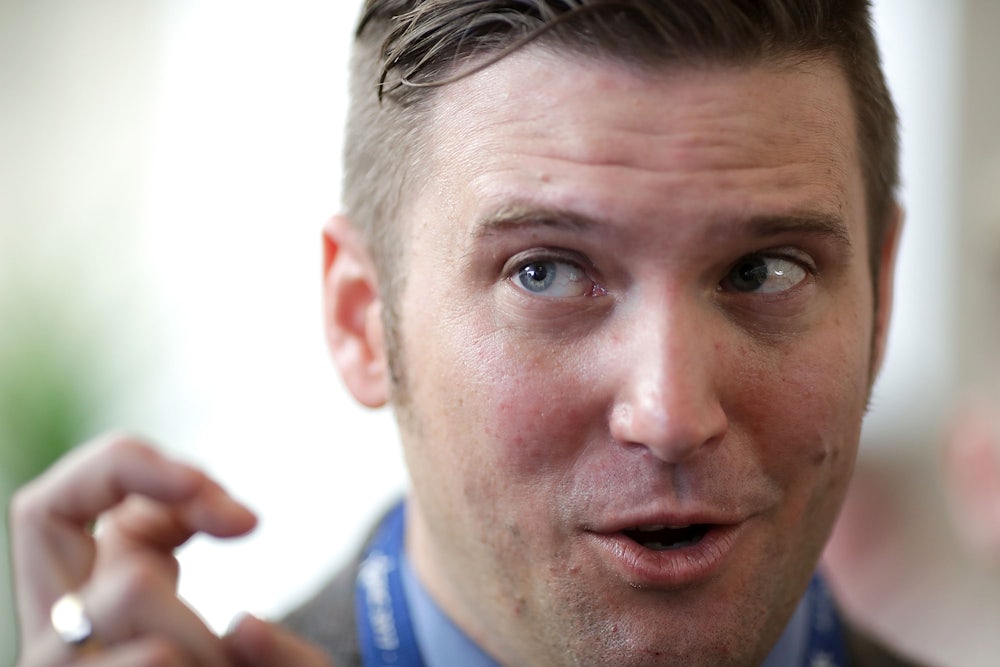The annual Conservative Political Action Conference began in earnest Thursday with a baffling speech by Dan Schneider, executive director of the American Conservative Union, who denounced the alt-right as “a sinister organization that is trying to worm its way into our ranks.” Since the alt-right is the latest incarnation of white nationalism, Schneider’s censure was welcome, but it was confused by his attempt to make a distinction between a good alt-right and a bad alt-right, a spurious analysis bolstered by bad history. He referred to today’s alt-right, which is a diffuse mass movement with no centralized hierarchy, as an “organization.”
“Just a few years ago, this hate-filled left-wing fascist group hijacked the very term ‘alt-right,’” Schneider claimed. “That term has been used for a long time in a very good and normal way.”
As it happens, the man who coined the phrase alt-right, was in the audience while Schneider spoke. “I invented #AltRight!?” Richard Spencer tweeted, and in a press gaggle in the CPAC hallway he pushed a white nationalist message that’s always been the core of the alt-right. “Do they grant a white person the moral legitimacy to stand up for himself? To have an identity? I would ask that,” he said, according to Slate. “Are you morally opposed to white people understanding themselves?”
Schneider’s confusion is a symptom of CPAC’s conundrum with the alt-right, an ideology closely associated with Donald Trump’s rise and with the ongoing transformation of American conservatism since the election. Like other legacy conservative institutions, CPAC wants to curry the approval of the new dispensation and also to harness the energy of young people mobilized by the alt-right. But unvarnished white nationalism of the Spencer variety is still beyond the pale.
So the drama of this year’s CPAC revolves around how conservatives should handle the alt-right. The solution, so far, has been to make a gingerly attempt to separate out the more socially acceptable parts of the alt-right while distancing CPAC from figures like Spencer, who would remind the press and larger public that we are dealing with neo-Nazi ideologues.
But you cannot whitewash the alt-right, nor deny its influence in today’s conservative movement or the highest levels of the Trump administration.
As Schneider spoke, a banner behind him featured the logo of Breitbart, one of the sponsors of this year’s CPAC. The right-wing website has been described as “the platform of the alt-right” by none other than former CEO Steve Bannon, who in his capacity as the chief strategist of the Trump White House, was an honored guest at CPAC. As Slate’s Michelle Goldberg wrote, Schneider’s rewriting of alt-right’s history may have been to justify Bannon’s attendance at CPAC.
But CPAC wasn’t sure what to do with another Breitbart stalwart, the incendiary writer Milo Yiannopoulos, who was initially slated as the conference’s keynote speaker. Milo Yiannopoulos, who describes himself as a “fellow-traveller” of the alt-right, is a self-styled provocateur famous for countless racist, sexist, and transphobic comments. None of this bothered CPAC, but they rescinded their invitation when the press rediscovered an interview in which Yiannopoulos defended sex between “13-year-olds” and “older men.” (In the aftermath of the controversy, Yiannopoulos also lost a book contract and resigned from Breitbart.)
While Yiannopoulos’s praise for child sexual abuse isn’t necessarily reflective of his alt-right worldview, they do have one thing in common: Intentional provocation. In a Breitbart article defending the alt-right, Yinnopoulos argues that the disturbing racist and anti-Semitic comments made by many alt-right adherents should be seen as an outgrowth of a “youthful, subversive, underground” milieu.
By CPAC’s reckoning, one major figure of the alt-right was worthy of being feted (Bannon), another deserved a keynote speech until an embarrassment surfaced (Yiannopoulos), and a third merited outright rejection: After his ad-hoc press conference, Spencer was ejected from CPAC.
And yet, even as CPAC tries to wash its hands of Spencer, he’s clearly popular with many conference attendees In Slate’s Osita Nwanevu described a telling scene:
Not long after Spencer stepped out of the ballroom, he was spotted by two young white people, one of whom jumped and nearly squealed to his friend with glee.
“It’s him!” the fan exclaimed. This was J.P. Sheehan, a College Republicans president at an undisclosed New England school. “He’s, like, the coolest guy.” Out of nowhere, Sheehan, in a black Make America Great Again cap, produced a T-shirt sold by Spencer’s Radix Journal and waved it in front of Spencer to get his attention.
A few other young attendees then quickly recognized Spencer and approached him for photos, and the gaggle of reporters quickly and exponentially grew.
Like CPAC, the conservative movement faces a difficult choice. Many aspects of the alt-right, especially as articulated by outspoken figures like Spencer, are highly unpalatable to older right-wingers. Yet the alt-right clearly has momentum and is drawing fresh, youthful blood into the right. The current solution of accepting Bannon but rejecting Yiannopoulos and Spencer is a temporary compromise, one that is unlikely to last. Soon conservatism will have to face its moment of truth: Do they accept the alt-right as the future of American conservatism?
